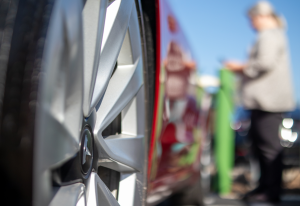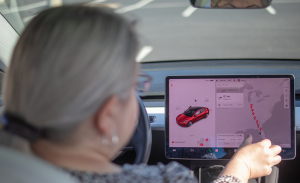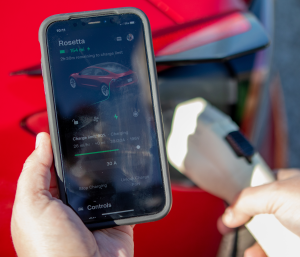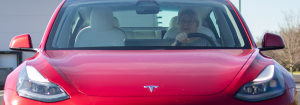‘Let’s Take It,’ Part I
(This is the first of a two-part series about Power Moves team member Laura Matney’s road trip to Florida. You can read Part II here.)
An unexpected inquiry led to an electric vehicle purchase – and planning a long-distance road trip
A chance meeting left Laura Matney beaming at the thought that a new family vehicle could become a getaway car – to Florida.

Power Moves team member Laura Matney charges her Tesla at the Wabash Valley Power Alliance office in Indianapolis. She and her family are planning to take the car on a road trip from Central Indiana to Sarasota, Fla.
Matney, the marketing manager for Wabash Valley Power Alliance and member of the Power Moves® team, was planning to sell her family’s sedan by the end of 2023 when a friend approached her in January. Matney’s friend admired the car and asked about possibly buying it – which also meant that Matney would need to begin shopping for a replacement vehicle. As Matney planned to meet another friend in Sarasota, Florida, an idea raced into her mind: the family could take a new vehicle on its maiden road trip to “The Sunshine State.”
It would be a unique test drive: the Matneys replaced their gas-powered sedan with an electric Tesla Model 3.
“One of the reasons we bought a Tesla instead of another electric vehicle was because we wanted to take longer car trips, and we are comfortable with the buildout of the Tesla Supercharger network,” Matney said. “So we said ‘Let’s take it. Let’s see what we think about it.’”

Power Moves team member Laura Matney plots out her Florida road trip on the computer in her Tesla. The Tesla can highlight chargers along the way to help drivers plan for recharging for long-distance travel.
Matney already experienced driving a Tesla and other electric vehicles; her family owns an electric Chevy Bolt and she also regularly drives the Tesla Model 3 that is part of the WVPA vehicle fleet. The Tesla Supercharger network includes more than 40,000 chargers, the company wrote on its website. Matney has previously driven the WVPA Tesla from Indianapolis to Fort Wayne, Indiana, and even to Missouri.
Matney ultimately bought a used 2021 Tesla Model 3. She routinely drives it on her more than 100-mile commute from her Columbus, Indiana, home to WVPA. Her husband also has enjoyed driving it.
“They’re peppier than gas-powered vehicles,” Matney said of electric vehicles. “They have that immediate response when you put your foot on the accelerator. We also like the regenerative braking, and it takes some getting used to when we go back to our gas-powered vehicle.”

Power Moves team member Laura Matney charges her Tesla electric vehicle while looking at the car’s app on her cell phone.
They began planning the April trip to Sarasota in February, making sure to account for supercharger stops where they can visit locations such as restaurants. A Tesla Supercharger can charge a vehicle up to 200 miles in 15 minutes, the company reported on its website.
Matney uses the Tesla onboard navigator to plan her trips, including the trip to Sarasota. The navigator can show supercharger locations and nearby amenities.
“What I have experienced so far is that some of the other EV charger networks aren’t always located where you have a place nearby if you want to stop,” Matney said. “If you have been driving for 2 or 3 hours, you may want to take a break or walk around. I think Tesla made good choices where they put their superchargers.”
Matney, who is traveling to Florida with her husband and daughter, plans to drive over two days each way, with a stay in Tallahassee, Florida, while traveling south and staying in Montgomery, Alabama, while driving back to Indiana.

Laura Matney’s family will take their new Tesla on a road trip to Florida later this month. Tesla states on its website that one of its Superchargers can charge a vehicle up to 200 miles in 15 minutes.
The trip can be another example of how electric vehicles and their infrastructure are improving. Matney has taken the WVPA Tesla to public information sessions about EVs. She frequently answers questions from people concerned about electric vehicles’ ranges and the time it takes to charge them.
“Getting in a car and getting someplace has been around for so long that humans are conditioned to do it and we don’t think about it. We just know that a gas station is going to be around near where we need it,” Matney said. “Because there aren’t a lot of charging stations right now for EVs compared to gas stations, it’s a slightly different way of thinking. You just have to do a little bit more planning.”
This is the first in a two-part series highlighting Power Moves team member Laura Matney’s family road trip from Central Indiana to Sarasota, Florida, in a 2021 Tesla Model 3.